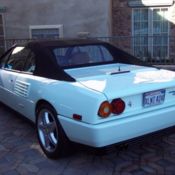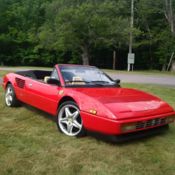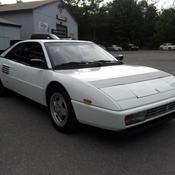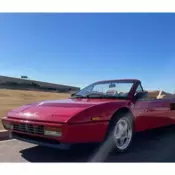Ferrari 1991 Mondial t Spider Convertible 2+2 300 hp 4 seater
| Condition: | Used |
| Make: | Ferrari |
| Model: | Mondial |
| SubModel: | Mondial t |
| Type: | Convertible |
| Year: | 1991 |
| Mileage: | 39,844 |
| VIN: | ZFFRK33AXM0088408 |
| Color: | Red |
| Fuel: | Gasoline |
| Transmission: | Manual |
| Drive type: | RWD |
| Interior color: | Tan |
| Vehicle Title: | Clear |
| Item location: | West River, Maryland, United States |
| Extras |
|
New Alpine stereo CD with amplifier, Power Locks, Power Windows Power antenna, Leather Seats, CD Player, Convertible |
| Listed by | Private seller |
Description of 1991 Ferrari Mondial Mondial t |
|||||||||||||||||||||||||||||||||||||||||||||||
|
Ferrari Mondialt, 991, 9,844 Original Miles. Perfect color combination.VeryClean and fun. 300 HP 3.4L Quick. Tight steering and great handling. This was the best of all the Monidials' for several reasons. I added some information about the cars history for you to understand the car better. The pictures and historybelow are from Wikipedia.Remember this car is the ( t ). As usual, he car is so much more beautiful in person. Bright shinny paint, eather is in excellent condition. Beautifully designed by the famous Pininfarina. Just hada new radio and amp. put in last Oct.2014, maybe 3-400 miles ago) as well asthe radiator replaced and some hoses, omplete overall check. New oil change, attery ( I keep on a battery tender when not in use) andcomplete new fuse andmodulepanel. This car is fast and fun. It revs like a two cycle engine and the red line is at 7500 rpm's and sounds awesome. Belt service was about 4000 miles ago.Let me know if you need more information or want to set up an inspection 410.991.2931. I have 3 convertibles but I will miss this one.CONVERTIBLE WEATHER AND SEASON IS HERE!Why buy aCorvette when you can own a Ferrari for the same price!Great investment quality. The dash is in perfect condition with no scratched or cracks as is the whole interior except a couple light cracks on the drivers seat. the tires are Toyo like new, indshield and all glass is clear and clean, ithout scratches. Also has the original leather tool box, omplete except the tow hook (I'll try to get one), nd the leather manual holder This car didn't come with the optional spare tire, ut it has the original can of air.The car is for sale locally and I reserve the right to end the sale early.
The Ferrari Mondial is a 2+2coupeautomobile produced by Ferrari from 1980 through 1993. It replaced the angular 208/308 GT4. The "Mondial" name came from Ferrari's history — the famed 500 Mondial race car of the early 1950s. Despite its predecessor being Bertone styled, he Mondial saw Ferrari return to Pininfarina for styling. It was sold as a mid-sized coupe and, ventually, cabriolet. The Mondial was conceived as a 'usable' model, ffering the practicality of four seats and the performance of a Ferrari. The car had a slightly higher roofline than its stablemates, ith a single long door either side, ffering easy access and good interior space, easonable rear legroom, hile all-round visibility was excellent. History The Mondial was produced in fairly high numbers for a Ferrari, ith more than 6,100 produced in its 13-year run, nd was one of Ferrari's most commercially successful models. The car body was not built as a monocoque in the same way as a conventional car; the steel outer body was produced by the famous Italian coachbuilder Carrozzeria Scaglietti, ust down the road in nearby Modena, uilt over a lightweight steel box-section space frame. The engine cover and rear luggage compartment lids are in light alloy. The seats and interior were trimmed in Connolly hide, ontrasting with the body color. Most cars were painted rosso red, ut some were black or silver, nd a few were dark blue. The Mondial was the first Ferrari car where the entire engine/gearbox/rear suspension assembly was mounted on a detachable steel subframe, aking engine removal for a major rebuild or cylinder head removal much easier than it was on previous models. Unusually, he handbrake is situated between the driver's seat and the inner sill. Once the handbrake is set it drops down so as not to impede egress and ingress. Instead of the conventional "H" shift pattern, he gearbox has 1st gear situated in a "dog leg" to the left and back, ehind reverse. This pattern allows quicker gear shifts between 2nd and 3rd gear, nd also between 4th and 5th. The Mondial had undergone many updates throughout is production life cycle. There were four distinct iterations (8, V, .2, nd t), ith the latter 3 having two variations each. (coupe and cabriolet) Starting with the 1980-1982 Mondial 8, hat was intended to be an entry-level performance vehicle within the Ferrari lineup, roved to be a disappointment to some Ferrari enthusiasts. The car was plagued with major mechanical and reliability issues, nd was powered by a relatively weak 214 horsepower engine. Safety requirements also forced Ferrari to install large black colored bumpers which some felt was awkward in design. The automotive press was often critical of the Mondial 8. Time magazine went on to include the Mondial 8 as one of the 50 worst cars of all time, s well as being nominated for the Top Gear search of the Worst Car In The World. Much of the stigma bestowed upon later Mondials can be traced to this initial model. In 1982, errari quickly remedied the situation by upgrading the engine just two years later with a new four-valve head. This model was known as the Mondial Quattrovalvole or QV. It shared its engine with the contemporary 308 GTB/GTS QV A new cabriolet version was also introduced that would be carried forward to the two subsequent models. These models would be produced between 1982-1985. This model was much better received by the automotive press and the public. This model had a 4 year production run until 1985. The next evolution would be the Mondial 3.2, hich saw the engine grow in power (266HP) and styling refreshed. This car enjoys much popularity due to one of the last Ferrari to have the relatively reliable and approachable maintenance of the 328 drivetrain. The final model (1989-1993), he Mondial t was the biggest change for the model. With a larger engine (300HP), much substantial update to styling, nterior ergonomics and a completely different engine layout. Mondial t
The final Mondial evolution was 1989's Mondial t (Coupe and Cabriolet). It was a substantially changed model, spearhead of a new generation of V8 Ferraris", ccording to Road & Track magazine. It was visually different from preceding Mondial models, he most recognisable being the redesign of the air intakes to a smaller, eater rectangular shape. Additionally, he door-handles were of a visually different design and the bumpers became body coloured.
Mondial t coupe. The 't' called attention to the car's new engine/transmission layout: the previously-transverse engine was now mounted longitudinally whilst the gearbox remained transverse, hus forming a 't'. By adopting this layout, longer engine could be mounted lower in the chassis, mproving handling dramatically. The 't' configuration was used by Ferrari's Formula One cars of the 1980s, nd would be the standard for the marque's future mid-engined V8 cars, eginning with the 348, ntroduced later in the year. The transverse manual gearbox was fitted with a Limited Slip Differential with a twin-plate clutch design with bevel gears driving the wheels. Later in production, Semi-automatic transmission termed "Valeo" was available as an option; while shifting was by means of a traditional gear lever, he clutch was actuated automatically without a clutch pedal. The engine was up to 3.4L (3405cc) and 300hp (224kW). The engine was now controlled by BoschMotronic DME 2.5 (later DME 2.7) electronic engine management that integrated EFI and ignition control into a single computer unit. Two of these were used in the car: one for each bank of the engine. Engine lubrication was upgraded to a dry-sump system. The Mondial's chassis would underpin a new generation of 2-seat Ferraris, ight up to the 360, ut the 2+2 Mondial would end production just four and a half years later in 1993. However, he "t" layout of the engine and transaxle, dapted from Ferrari's Formula One cars, ontinues to be used in mid-engined V8 model Ferraris to date, lbeit with a more sophisticated chassis. The new layout saw the engine and transmission mounted on a removable subframe; the assembly could be removed through the underside of the vehicle for maintenance. This is necessary for timing belt replacement, aking this a costly procedure for the owner who does not have a lift. On the other hand, he clutch was now located at the very rear of the drive train. This makes clutch replacement and service a simple, nexpensive, nd readily owner-doable proposition. The "t" was home to other Ferrari firsts: It used power assisted steering for the first time, nd had a 3-position electronically controlled suspension for a variable trade off between ride quality and road holding. It also had standard ABS. The Mondial t represented the most substantial upgrade to the Mondial model line in performance and handling since its introduction in 1980. Previous Mondials had rarely justified their price premium over the competition in terms of bare performance statistics, hich led to some poor press coverage. The "t" offered greater performance whilst retaining a mid-engined layout and a practical packaging layout, nd was more favorably received. It also had the advantage of two usable rear seats. The company has not produced a mid-engined 2+2 car since then, eaving the 2+2 configuration to the more classic front-engined design starting with the 456 in 1992. As of 2012, he V12FF along with the V8California are the company's only 4-seat vehicle offerings, ut both of these are front engined, eaving the Mondial t as the most modern 4-seat, id-engined, errari yet produced. Between 1989 and 1993 Ferrari produced 858 coupés and 1,017 cabriolets. PPG Pace Car The Mondial based Ferrari PPG Pace Car was built exclusively for PPG Industries to use as a safety car for the PPG Indy Car World Series as part of its pace car program. Built by Ferrari under the design of I.DE.A Institute at a cost of approximately $1 million, t was introduced at the 1989Champion Spark Plugs 300 in Laguna Seca.[3] |
 Home
Home Contact us
Contact us NEWEST CARS
NEWEST CARS SELL YOUR CAR
SELL YOUR CAR FAQ
FAQ







